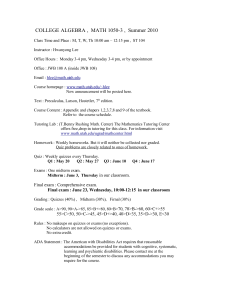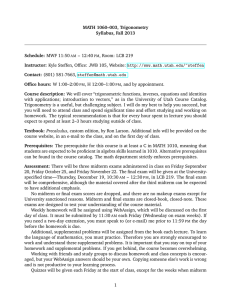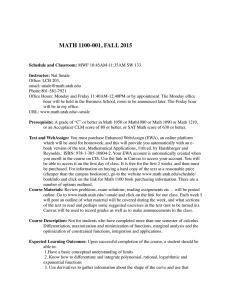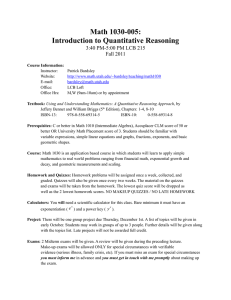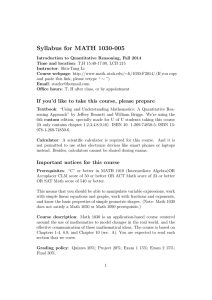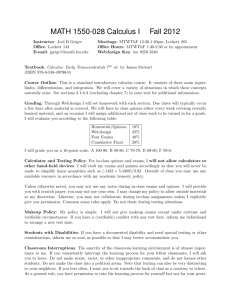Math 1100: Quantitative Analysis Fall 2013 Instructor: Sarah Cobb Office:
advertisement
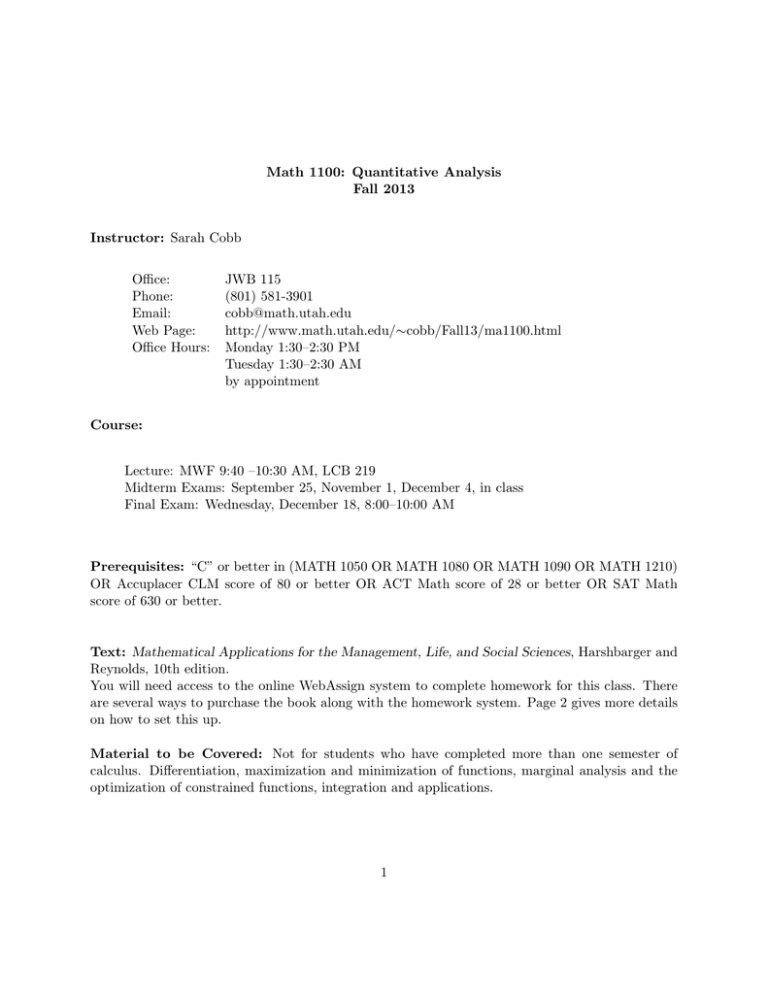
Math 1100: Quantitative Analysis Fall 2013 Instructor: Sarah Cobb Office: Phone: Email: Web Page: Office Hours: JWB 115 (801) 581-3901 cobb@math.utah.edu http://www.math.utah.edu/∼cobb/Fall13/ma1100.html Monday 1:30–2:30 PM Tuesday 1:30–2:30 AM by appointment Course: Lecture: MWF 9:40 –10:30 AM, LCB 219 Midterm Exams: September 25, November 1, December 4, in class Final Exam: Wednesday, December 18, 8:00–10:00 AM Prerequisites: “C” or better in (MATH 1050 OR MATH 1080 OR MATH 1090 OR MATH 1210) OR Accuplacer CLM score of 80 or better OR ACT Math score of 28 or better OR SAT Math score of 630 or better. Text: Mathematical Applications for the Management, Life, and Social Sciences, Harshbarger and Reynolds, 10th edition. You will need access to the online WebAssign system to complete homework for this class. There are several ways to purchase the book along with the homework system. Page 2 gives more details on how to set this up. Material to be Covered: Not for students who have completed more than one semester of calculus. Differentiation, maximization and minimization of functions, marginal analysis and the optimization of constrained functions, integration and applications. 1 Grading: Your grade will be computed based on homework, quizzes, and exams: Homework and Quizzes 25% Exam 1 15% Exam 2 15% Exam 3 15% Final Exam 30% Your final grade will be based on the percentage attained: A (93-100), A- (90-93), B+ (87-90), B (83-87), B- (80-83), C+ (77-80), C (73-77), C- (70-73), D+ (67-70), D (63-67), D- (60-63), E (0-60) Online Homework: Homework will be assigned daily using the WebAssign system. It will be due at 9:00 AM most days that we have class. The purpose of the homework is to help you understand the material for the class. I encourage you to take the homework seriously and put in as much effort as you need to to thoroughly understand the mathematics. The WebAssign system includes many resources to help you, including videos, tutorials, and additional problems. Your textbook, of course, is also an excellent resource. The three lowest scores will be dropped. Setting up WebAssign: Visit http://www.webassign.net/. On the right side of the screen, enter “utah” for your institution. This will take you to a page where you can login using your CIS username and password. (Note: it is difficult for me to test this. If this does not work, I will email corrected instructions to your university email account.) Written Homework: There will also be daily paper homework due in class. This will generally include one or two conceptual questions and one or two problems similar to the online homework. It will be distributed in class and also available on the course website. The work you turn in should be very neat: all work shown, minimal errors, additional pages stapled to the one handed out in class, and no paper from spiral notebooks unless the edges are carefully trimmed. If your work does not meet these standards, it will be returned ungraded. The three lowest scores will be dropped. Quizzes: A quiz will be given most Wednesdays at the beginning of class covering material from the previous week. Your lowest score will be dropped. No make-up quizzes will be given except as required for university-excused absences. Exams: There will be three midterm exams and a final. The midterm exams will be September 25, November 1 and December 4. You are expected to take these exams in class at the scheduled time. No make-up exams will be allowed except as required for university-excused absences. Your lowest midterm exam score will be replaced with your score on the final exam if your final exam score is higher. The final is Wednesday, December 18, 8:00–10:00 AM and cannot be taken early or late for anything but the most dire emergencies. 2 Calculators: No calculators will be allowed on quizzes or exams. You may do as you like on the homework, but I encourage you to avoid using a calculator as much as possible. You are expected to be able to add, subtract, multiply, and divide numbers using a pencil and paper. If you need help with these processes, I would be happy to discuss them with you during my office hours. Working Together: Collaborating on homework is allowed and encouraged. By submitting an answer to a homework problem, you certify that you understand the process and could do a similar problem on your own. Working together on quizzes or exams, of course, is not allowed. Tutoring: The math department offers free tutoring in the tutoring center in the basement of LCB. Tutors will be available 8 AM to 8 PM Monday–Thursday and 8 AM to 4 PM on Fridays. You can find a private tutor through University Tutoring Services; the main office of the math department also maintains a list of private tutors. Computers: I do not allow the use of computers in the classroom. Even with the best of intentions, it is far too easy to shift from taking notes to playing Solitaire. Not bringing your computer spares you the temptation. If this policy is a serious problem for you, please talk to me. Classroom Behavior: Please be respectful in the classroom. Don’t sleep, talk to each other, do homework, eat noisy food, text your friends, use a computer, or anything else that might distract your fellow students. Anyone disrupting class will be asked to leave. Cheating: Cheating demonstrates a lack of respect for yourself, your fellow students, your instructor, the university, and the whole academic enterprise. If you cheat on an exam, you will receive no credit for that exam. Repeated incidents may be cause for more serious action, such as failing the course or expulsion from the university. Changes: Parts of this syllabus may alter in the course of the semester. Whenever possible, I will both announce this in class and send an email. You are responsible for knowing everything I email to your university mailing address as well as everything I say in class. If it is unavoidable that you miss class, make sure you talk to someone who was there. Office hours: Working with individual students is the best part of teaching. I hope that you will come to my office hours. I have scheduled office hours each week, listed above. If your schedule conflicts with these, send me an email and we can set up another time. Communicating with me: The best way to reach me is by email (my address is on page 1). I will generally respond to email within 24 to 48 hours. I will also be in my office during my office hours; you should feel free to drop by. Any communication not in writing or by email should be considered unofficial. 3 ADA statement: The Americans with Disabilities Act requires that reasonable accommodations be provided for students with physical, cognitive, systemic learning, and psychiatric disabilities. Students need to contact the instructor at the beginning of the semester to discuss any such accommodations that they may require for this course. Missing work: I will drop three homework assignments (written and electronic) and one quiz when I compute your grade. If your grade on the final exam is higher than your lowest midterm exam grade, I will replace that score with the one from the final. These policies are intended to account for illness or other circumstances that interfere with your work. No other accommodations will be made except in cases of prolonged, unavoidable absence or as required for university-excused absences. Succeeding in a math class: In order to succeed in a math class, it is vital that you complete homework assignments fully and punctually. Ideally, you should be working homework problems after each class to make sure you have mastered the concepts, because we will build on them in the next class. More than in most disciplines, you learn math by working problems, not by listening to a lecture. If you start to get lost, get help quickly from a classmate, at the tutoring center, or from me. It is very difficult to recover once you get behind. What to do if you are confused Many resources are available to help you if you struggle in this class. If you find you are having difficulty with the homework, or that you are not doing as well as you hope on quizzes and tests, here are some suggestions. • Read the textbook. The sample problems are likely to be helpful. • Make use of videos and tutorials available through WebAssign. • Form study groups. • Go to the math tutoring center. • Talk to me. I will generally respond to email within 24-48 hours; I have weekly office hours; I am happy to make appointments. 4
